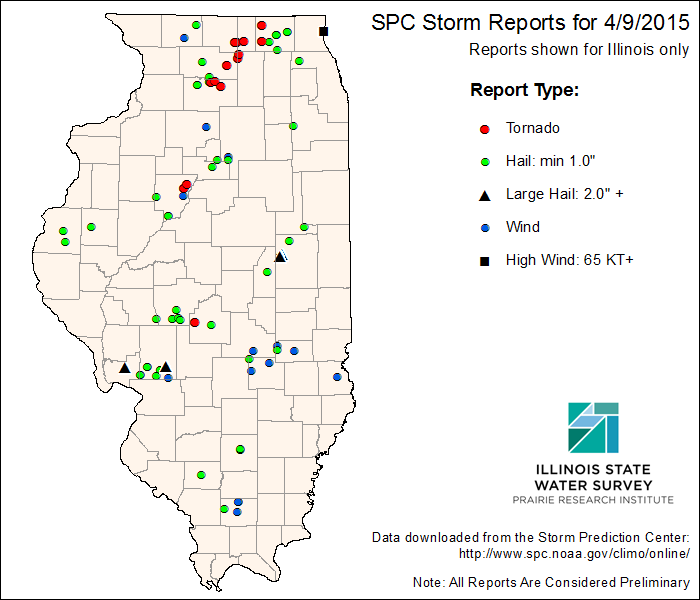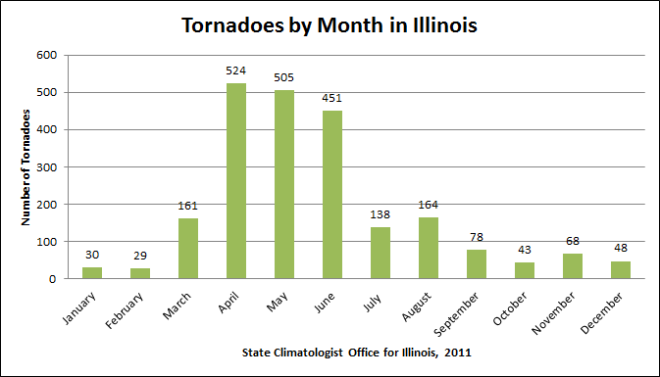Yesterday I mentioned the national archive as a source for reports on tornadoes and other forms of severe weather. Today I wanted to mention the NOAA Storm Prediction Center and the many statistical products they have available on their website. Of course, their primary mission is to provide forecasts but they have accumulated an impressive collection of other products as well.
While these are preliminary and subject to change later, one of the best and longest-lived product the SPC provides are the daily storm reports. These are dot maps showing tornadoes, wind and hail damage, with a detailed list below the map showing dates, times, cities, counties, type of damage. You can see “today” and “yesterday” or pick your own date. See example below (click to enlarge).

Monthly and Annual Tornado Summary
This page starts by giving you a table of running totals of tornadoes and tornado deaths for this year, and the last 3 years, plus the 3-year average. So as of April 3, we have 81 tornadoes reported across the US with zero deaths.
TORNADO TOTALS AND RELATED DEATHS...THROUGH THU APR 3 2014
NWS STORM PREDICTION CENTER NORMAN OK
0833 AM CDT FRI APR 04 2014
...NUMBER OF TORNADOES... NUMBER OF KILLER
TORNADO DEATHS TORNADOES
..2014.. 2013 2012 2011 3YR 3YR 3YR
PREL ACT ACT ACT ACT AV 14 13 12 11 AV 14 13 12 11 AV
--- -- -- --- ---- ---- ---- -- -- --- -- --- -- -- -- -- --
JAN 4 -- 75 79 16 57 0 1 2 0 1 0 1 2 0 1
FEB 41 -- 39 57 63 53 0 1 15 1 6 0 1 7 1 3
MAR 25 -- 18 154 75 82 0 0 43 1 15 0 0 10 1 4
APR 11 -- 86 206 758 350 0 1 6 363 123 0 1 1 43 15
MAY -- -- 268 121 326 238 -- 41 0 178 73 -- 5 0 9 5
JUN -- -- 125 111 160 132 -- 1 4 3 3 -- 1 2 1 1
JUL -- -- 72 37 103 71 -- 0 0 0 0 -- 0 0 0 0
AUG -- -- 46 38 57 47 -- 0 0 2 1 -- 0 0 2 1
SEP -- -- 21 39 51 37 -- 0 0 0 0 -- 0 0 0 0
OCT -- -- 61 37 23 40 -- 0 0 0 0 -- 0 0 0 0
NOV -- -- 79 7 44 43 -- 8 0 5 4 -- 3 0 2 2
DEC -- -- 18 53 15 29 -- 2 0 0 1 -- 2 0 0 1
--- -- -- --- ---- ---- ---- -- -- --- -- --- -- -- -- -- --
SUM 81 -- 908 939 1691 1179 0 55 70 553 227 0 14 22 59 33
PREL = 2014 PRELIMINARY COUNT FROM ALL NWS LOCAL STORM REPORTS.
ACT = ACTUAL TORNADO COUNT BASED ON NWS STORM DATA SUBMISSIONS.
COMPARISONS BETWEEN PRELIMINARY AND ACTUAL COUNTS SHOULD BE AVOIDED.
..CARBIN..04/04/2014
And if you look beyond the table you can get a year by year summary for the US. For example, here is the summary for 2014 so far.

I like to check the Illinois statistics periodically so I choose the year and then the state and look at reports like this one …

Annual Fatal Tornado Summary
This is a nice, modern interface for mapping fatal tornadoes across the US.

Warning Coordination Meteorologist page
Because this page is geared towards NWS meteorologists, it has more extensive and technical information than the other pages. However, it has lots of information of general information. You can find maps of tornadoes by year, basic tornado climatology, number of watches issued by year, severe weather databases, and GIS support. For example, you can find the map of the number of tornadoes by county across the US.










